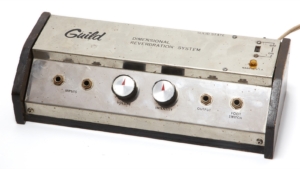
Introduction
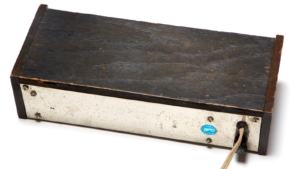
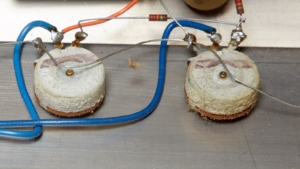
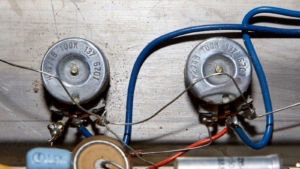
After spending far too many hours trying to find an ad or a catalog or anything containing the Guild Dimensional Reverberation System, I came up with precisely nothing. Zip. Nada. Bubkis. So I emailed Hans Moust, writer of the Guild Guitar Book, with whom I have an amiable relationship wherein I badger him with weird questions and he politely answers, no doubt too polite to ask me to stop asking him such weird questions. Sadly, even Hans had no information for me, and you know you’re in deep when Hans can’t help you with a Guild question. I did discover a price list entry from 1965 that lists simply Revrn Converter for $99.50, so I wonder it that’s what this is.
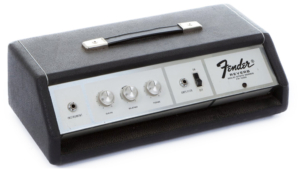
Many searches pertaining to Guild Reverb, when not matching amplfiers with reverb in the name, seemed to hit on the old Binson Echorec and Watkins/WEM Copicat tape echo machines, probably because those were actually popular and well-regarded units wheras the Guild Dimensional Reverberation System seems to have been lost to obscurity.
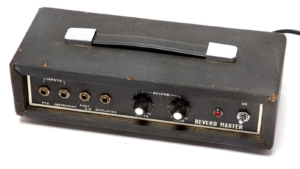
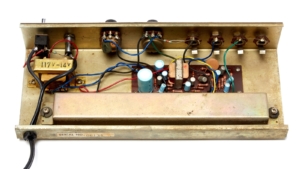
For now, the source of the Guild Dimensional Reverberation System remains a mystery. If you have one or know anything about the story behind this rare piece of Guild hardware, please contact me or leave a comment.
Controls
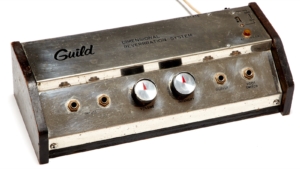
The first knob is volume which is a bit odd because it appears to be capable of muting the signal entirely. That’s not something I’d consider a value-add in a tool like this, but it may also be able to provide a bit of drive which is interesting, though sadly I could not prove this since my unit is essentially non-functional.
The Intensity knob is what controls how much reverb you get in the signal which, given my experience with other Guild electronics, is likely adjustable from none to please make it stop, but as I already mentioned I was unable to prove any of this.
Electronics
The Dimensional Reverberation System is basically a spring reverb tank with a small driver circuit and power supply packed into a nice metal and wood case. The two inputs in parallel and the gain is provided by an old transister making this a solid state unit as advertised on the top.
This is a metal-cased electrical device that has no ground lug on the plug. Is that bad? Yes. The end.
OK, not the end. Why is it a problem? Because the case is metal and there is no grounding through that missing third lug, so any time you touch the chassis you risk becoming the ground path, and as anyone who was around when guitar amps had only two lug power cords and a ground-lift switch will tell you, getting shocked it not fun and can even be lethal.
The tank is 9.25 inches long from flang tip to tip with two springs. I could not find any markings at all on the tank though it is possible there are markings under the circuit board since I did not remove that. This device was made back in the days when point-to-point wiring was still a common assembly technique, even when combined with turrets and circuit boards as seen here, so moving components without unsoldering the entire affair is not a simple process.
The two input jacks are wiring in parallel which means plugging in two instruments can change the impedance of the input and cause some nice tone-suck. Since the inside of the unit is wired with a combination of wiring and since there are directly soldered components along with big capacitors crammed in where they found room for them, getting more detail than what you see in the pictures was not possible unless I wanted to pull it all apart.
I was not willing to pull it all apart. Unfortunately, the Guild Reveb… you know what, I’m not typing that all out anymore. This Guild thing doesn’t work. see? Much simpler.
The solid-state nature of the Guild Dimensional Reverberation System (is that name ridiculous or what?) means that it’s driven by transistors instead of tubes. There appears to be three in the circuit, and they all appear to be completely lacking labeling of any kind. That, coupled with the fact that pulling the circuit board off of the reverb tank seemed like a bad idea means that a) I can’t really tell you what’s going on electrically and b) I couldn’t fix it because I don’t have a schematic. Remember, my attempts at finding any useful information about this thing came up empty, so short of completely dismantling it and testing each component or tracing it all out and making my own schematic, it will sadly stay broken.
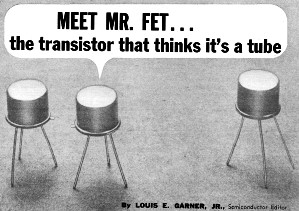
Sound
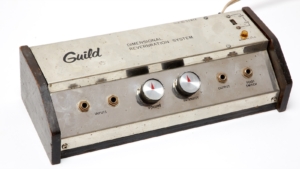
It powers up fine, and a degraded signal flows through it, and it even makes the proper thunderous noise when I rap on it with my knuckles, but unless I can prove that the drive circuit will make me sound like Brian Setzer or that the reverb will make me sound like The Ventures, restoring this rare Guild Dimensional Reverberation System (seriously, it’s not a system. It’s barely a unit!) will be relegated to the back burner behind the other 419 projects in the pile.
Conclusion
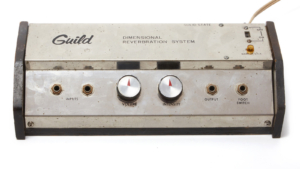

If you’ve got one that works or even looks to be in better condition than mine, please leave a comment. I’d love to see and hear it!
Donate: PayPal Crypto:
ETH: 0x0AC57f8e0A49dc06Ed4f7926d169342ec4FCd461
Doge: DFWpLqMr6QF67t4wRzvTtNd8UDwjGTQBGs

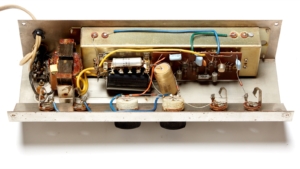
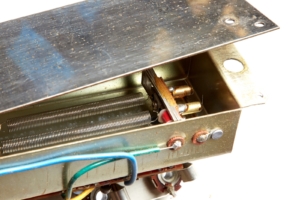
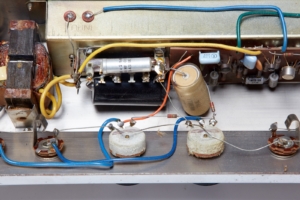
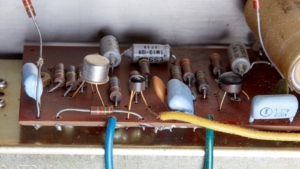
I have one of these units. Instead of the Guild name it has the name Kadent Dimensional Reverberation System. Same layout as yours. It had a small Guild sticker on the back. Mine also is not fully working. The dry guitar signal comes through but no wet signal. I’m getting a signal on the input side of the tank as seen on my scope but I need to turn the gain up on the scope all the way to see anything on the output side. Please contact me if you are interested.
Ooh I’d love to see pics! gad@gad.net
I currently have it apart trying to trace the problem. when I get a chance I’ll take some interior pics and some reassembled. The pot date codes are 67 01. The only difference I see is mine says Kadent where your’s has the Guild name. Also, the cabinet is a little lighter in color.
So cool – thanks!